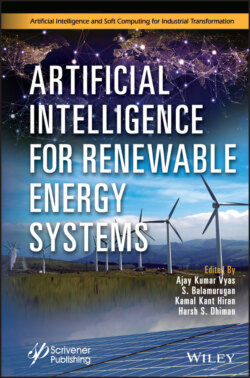Artificial Intelligence for Renewable Energy Systems

Реклама. ООО «ЛитРес», ИНН: 7719571260.
Оглавление
Группа авторов. Artificial Intelligence for Renewable Energy Systems
Table of Contents
List of Illustrations
List of Tables
Guide
Pages
Artificial Intelligence for Renewable Energy Systems
Preface
1. Analysis of Six-Phase Grid Connected Synchronous Generator in Wind Power Generation
1.1 Introduction
1.2 Analytical Modeling of Six-Phase Synchronous Machine
1.2.1 Voltage Equation
1.2.2 Equations of Flux Linkage Per Second
1.3 Linearization of Machine Equations for Stability Analysis
1.4 Dynamic Performance Results
1.5 Stability Analysis Results
1.5.1 Parametric Variation of Stator
1.5.2 Parametric Variation of Field Circuit
1.5.3 Parametric Variation of Damper Winding, Kd
1.5.4 Parametric Variation of Damper Winding, Kq
1.5.5 Magnetizing Reactance Variation Along q-axis
1.5.6 Variation in Load
1.6 Conclusions
References
Appendix
Symbols Meaning
2. Artificial Intelligence as a Tool for Conservation and Efficient Utilization of Renewable Resource
2.1 Introduction
2.2 AI in Water Energy. 2.2.1 Prediction of Groundwater Level
2.2.2 Rainfall Modeling
2.3 AI in Solar Energy. 2.3.1 Solar Power Forecasting
2.4 AI in Wind Energy. 2.4.1 Wind Monitoring
2.4.2 Wind Forecasting
2.5 AI in Geothermal Energy
2.6 Conclusion
References
3. Artificial Intelligence–Based Energy-Efficient Clustering and Routing in IoT-Assisted Wireless Sensor Network
3.1 Introduction
3.2 Related Study
3.3 Clustering in WSN
3.4 Research Methodology
3.4.1 Creating Wireless Sensor–Based IoT Environment
3.4.2 Clustering Approach
Algorithm 3.1 AI-based clustering approach
3.4.3 AI-Based Energy-Aware Routing Protocol
Algorithm 3.2
3.5 Conclusion
References
4. Artificial Intelligence for Modeling and Optimization of the Biogas Production
4.1 Introduction
4.2 Artificial Neural Network
4.2.1 ANN Architecture
4.2.2 Training Algorithms
4.2.3 Performance Parameters for Analysis of the ANN Model
4.2.4 Application of ANN for Biogas Production Modeling
4.3 Evolutionary Algorithms
4.3.1 Genetic Algorithm
4.3.2 Ant Colony Optimization
4.3.3 Particle Swarm Optimization
4.3.4 Application of Hybrid Models (ANN and Evolutionary Algorithms) for Biogas Production Modeling
4.4 Conclusion
References
5. Battery State-of-Charge Modeling for Solar PV Array Using Polynomial Regression
5.1 Introduction
5.2 Dynamic Battery Modeling
5.2.1 Proposed Methodology
5.3 Results and Discussion
5.4 Conclusion
References
6. Deep Learning Algorithms for Wind Forecasting: An Overview
Nomenclature
6.1 Introduction
6.2 Models for Wind Forecasting
6.2.1 Persistence Model
6.2.2 Point vs. Probabilistic Forecasting
6.2.3 Multi-Objective Forecasting
6.2.4 Wind Power Ramp Forecasting
6.2.5 Interval Forecasting
6.2.6 Multi-Step Forecasting
6.3 The Deep Learning Paradigm
6.3.1 Batch Learning
6.3.2 Sequential Learning
6.3.3 Incremental Learning
6.3.4 Scene Learning
6.3.5 Transfer Learning
6.3.6 Neural Structural Learning
6.3.7 Multi-Task Learning
6.4 Deep Learning Approaches for Wind Forecasting. 6.4.1 Deep Neural Network
6.4.2 Long Short-Term Memory
6.4.3 Extreme Learning Machine
6.4.4 Gated Recurrent Units
6.4.5 Autoencoders
6.4.6 Ensemble Models
6.4.7 Other Miscellaneous Models
6.5 Research Challenges
6.6 Conclusion
References
7. Deep Feature Selection for Wind Forecasting-I
7.1 Introduction
7.2 Wind Forecasting System Overview
7.2.1 Classification of Wind Forecasting
7.2.2 Wind Forecasting Methods
7.2.2.1 Physical Method
7.2.2.2 Statistical Method
7.2.2.3 Hybrid Method
7.2.3 Prediction Frameworks
7.2.3.1 Pre-Processing of Data
7.2.3.2 Data Feature Analysis
7.2.3.3 Model Formulation
7.2.3.4 Optimization of Model Structure
7.2.3.5 Performance Evaluation of Model
7.2.3.6 Techniques Based on Methods of Forecasting
7.3 Current Forecasting and Prediction Methods
7.3.1 Time Series Method (TSM)
7.3.2 Persistence Method (PM)
7.3.3 Artificial Intelligence Method
7.3.4 Wavelet Neural Network
7.3.5 Adaptive Neuro-Fuzzy Inference System (ANFIS)
7.3.6 ANFIS Architecture
7.3.7 Support Vector Machine (SVM)
7.3.8 Ensemble Forecasting
7.4 Deep Learning–Based Wind Forecasting
7.4.1 Reducing Dimensionality
7.4.2 Deep Learning Techniques and Their Architectures
7.4.3 Unsupervised Pre-Trained Networks
7.4.4 Convolutional Neural Networks
7.4.5 Recurrent Neural Networks
7.4.6 Analysis of Support Vector Machine and Decision Tree Analysis (With Computation Time)
7.4.7 Tree-Based Techniques
7.5 Case Study
References
8. Deep Feature Selection for Wind Forecasting-II
8.1 Introduction
8.1.1 Contributions of the Work
8.2 Literature Review
8.3 Long Short-Term Memory Networks
8.4 Gated Recurrent Unit
8.5 Bidirectional Long Short-Term Memory Networks
8.6 Results and Discussion
8.7 Conclusion and Future Work
References
9. Data Falsification Detection in AMI: A Secure Perspective Analysis
9.1 Introduction
9.2 Advanced Metering Infrastructure
9.3 AMI Attack Scenario
9.4 Data Falsification Attacks
9.5 Data Falsification Detection
9.6 Conclusion
References
10. Forecasting of Electricity Consumption for G20 Members Using Various Machine Learning Techniques
10.1 Introduction
10.1.1 Why Electricity Consumption Forecasting Is Required?
10.1.2 History and Advancement in Forecasting of Electricity Consumption
10.1.3 Recurrent Neural Networks
10.1.3.1 Long Short-Term Memory
10.1.3.2 Gated Recurrent Unit
10.1.3.3 Convolutional LSTM
10.1.3.4 Bidirectional Recurrent Neural Networks
10.1.4 Other Regression Techniques
10.2 Dataset Preparation
10.3 Results and Discussions
10.4 Conclusion
Acknowledgement
References
11. Use of Artificial Intelligence (AI) in the Optimization of Production of Biodiesel Energy
11.1 Introduction
11.2 Indian Perspective of Renewable Biofuels
11.3 Opportunities
11.4 Relevance of Biodiesel in India Context
11.5 Proposed Model
11.6 Conclusion
References
Index
Also of Interest
WILEY END USER LICENSE AGREEMENT
Отрывок из книги
Scrivener Publishing 100 Cummings Center, Suite 541J Beverly, MA 01915-6106
.....
In Equation (1.53), derivative component (i.e., with its elements with subscript p) is indicated by coefficient matrix E, with remaining terms (i.e., subscript k) of linearized machine equations are shown by the coefficient matrix F. Matrices E and F elements are defined in the Appendix.
During the analysis, it was assumed that the two sets of stator winding, say, abc and xyz, are identical. Hence, value of resistance and winding leakage inductance will be same (i.e., It may be noted that in figures of the following sections, dark and dash line indicate the real and imaginary component of eigenvalue, respectively.
.....